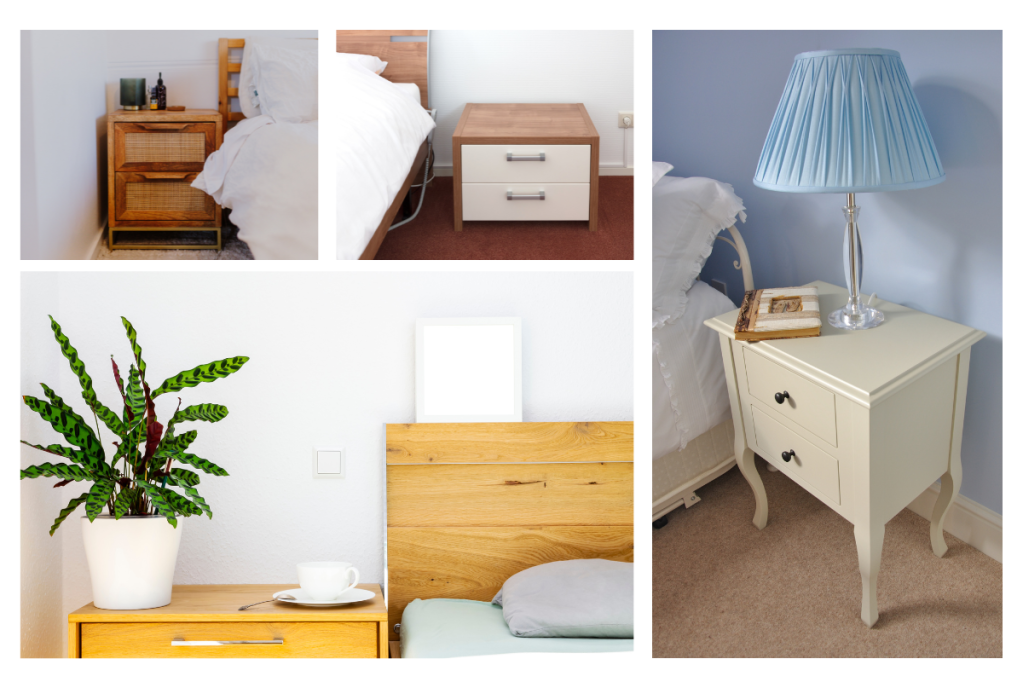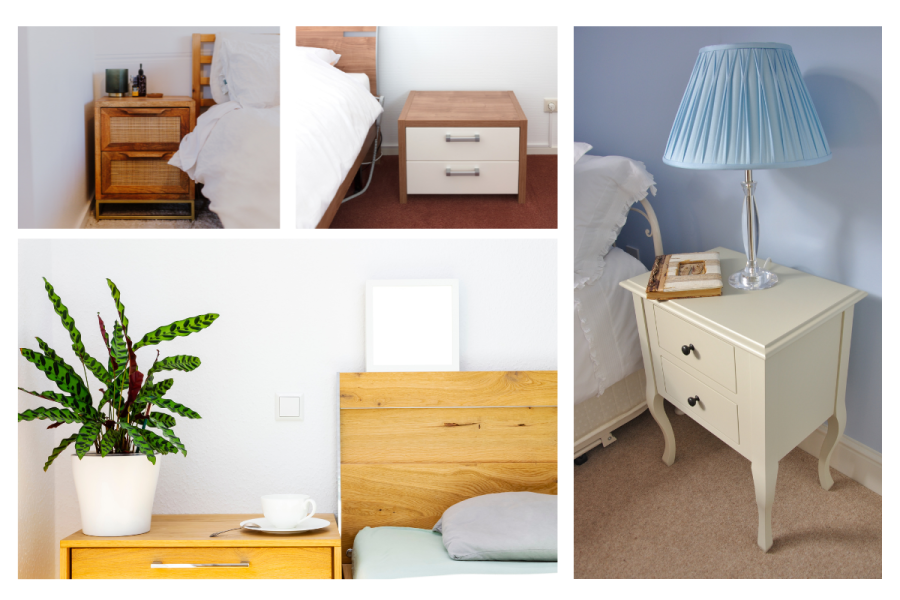Discover the fusion of functionality and aesthetics in modern bedside tables. Explore innovative designs, sustainable materials, and contemporary trends.

The Emergence of Modern Bedside Tables: A Historical Overview
Bedside tables have been refined and adapted over time. They’ve evolved into sleek, functional, and attractive furniture from bedside pedestals. In the early 20th century, bedside tables were used to hold chamber pots. The first ones were made of wood and had a single drawer.
Bedside tables evolved to serve new purposes as indoor plumbing grew increasingly common. They became more complicated and multifunctional in the 1930s and 1940s, with magazine racks, reading lamps, and built-in radios. They became more streamlined and simple in the 1950s and 1960s due to modern design.
Bedside tables with rich carvings and ornamentation returned in the 1970s and 1980s. By the 1990s, minimalism was back, and bedside tables became simpler and more utilitarian again. Modern bedside tables are usually made of wood, metal, or glass and have clean, simple lines and sleek forms that represent current sensibilities.
Consumer requirements and preferences have changed over the history of modern bedside tables. Bedside tables have become an important feature of modern interior design as technology and lives have changed.
Design Elements of Modern Bedside Tables: A Comprehensive Guide
Contemporary bedside tables are attractive and functional. They store books, lights, and alarm clocks while beautifying the bedroom. Choosing a modern bedside table involves various design factors.
Initially, the bedside table should be proportional to the bed and room. A modest bedside table next to a giant bed will look out of place, while a large table will overwhelm a small room. The table should be at a convenient height for accessing goods from the bed.
Second, the bedside table’s finish and material should match the rest of the room. Wood is adaptable and can be stained or painted to fit any design, making it a popular choice for modern bedside tables. Modern materials like metal and glass are also popular.
Thirdly, think about the bedside table’s storage. Books, periodicals, and other materials can be stored in a table with drawers or shelves, and people who use electronic devices in bed may benefit from a table with a charging station or USB ports.
The homeowner’s style should be reflected in the bedside table’s design. Contemporary bedside tables range from basic and streamlined to elaborate and extravagant. A table that matches the homeowner’s decor and personal style will serve its practical purpose and enhance the room’s attractiveness.
The Impact of Technology on Modern Bedside Table Design
Modern bedside tables have been transformed by technology. Bedside tables’ materials have changed the most due to technology. New materials are lighter, stronger, and more durable than wood and metal thanks to material science. Carbon fiber bedside tables, utilized in the aerospace industry, are becoming more popular due to their robustness and light weight.
Smart technology has also influenced modern bedside table design. Bedside tables today have LED lights, wireless charging stations, and speakers. The table’s functioning and the room’s aesthetic appeal are improved by these elements.
The design process has also been affected by technology. Computer-aided design (CAD) software lets designers generate increasingly complicated and intricate designs, while 3D printing lets manufacturers rapidly and easily construct prototypes and unique designs.
Finally, technology has changed how we use modern bedside tables. Smart home technology allows bedside tables to be incorporated into a smart home system, allowing users to manage lighting, temperature, and other functions using voice commands or smartphone apps.
Modern bedside tables are made and used differently thanks to technology.
Sustainability in Modern Bedside Table Manufacturing
Modern bedside tables are becoming more popular as consumers become more environmentally conscious. Sustainable bedside table production promotes recycling and waste reduction and uses environmentally friendly materials and techniques.
The materials utilized in sustainable bedside table manufacture are crucial. Sustainable bedside tables are created from renewable, biodegradable, or recycled materials. Modern bedside tables are created from bamboo, a renewable resource. Modern bedside tables also incorporate reused wood, recycled plastic, and glass.
Sustainable bedside table production includes waste reduction and resource conservation. Recycling, energy reduction, and eco-friendly manufacturing can accomplish this. Some firms employ solar electricity to power their factories, while others use water-based paints and finishes to limit chemical consumption.
Finally, sustainable bedside table production entails educating consumers about sustainability. Recycling, educational, and product certification programs can achieve this.
Sustainable modern bedside table production is crucial to responsible manufacture and consumption. Manufacturers may lessen their environmental effect while offering consumers with high-quality and fashionable products by employing sustainable materials and encouraging sustainable practices.
Contemporary Materials and Finishes for Modern Bedside Tables
Contemporary materials and finishes are essential to modern bedside table design, giving designers several alternatives to create unique and stylish pieces. Modern bedside tables include glass, acrylic, and metal for a sleek look. Glass is a versatile material that can be used to make a number of forms and styles and is sturdy and easy to clean.
Acrylic is another trendy modern bedside table material. Designers can create distinctive and eye-catching designs with this lightweight and durable material. Bedside tables that are regularly used should be made of acrylic because it is scratch-resistant and robust.
Modern bedside tables have a variety of finishes and modern materials. Matte finishes, for instance, are prevalent in current design. Nevertheless, glossy finishes bring glamor and refinement to any decor with their high-shine and reflective surface. Other common finishes include brushed metal, textured surfaces, and natural wood.
Modern materials and finishes can also be used to create remarkable designs. For instance, a bedside table with a glass top and a metal base can give a bedroom a modern, industrial style, while one with a glossy acrylic finish can offer elegance and sophistication.
Modern bedside table designers have many alternatives for creating unique and elegant pieces thanks to contemporary materials and finishes. Designers may make functional and attractive bedside tables by using materials like glass, acrylic, and metal and finishes like matte, glossy, and textured.
Conclusion
Modern bedside tables are an essential component of modern bedroom design. By considering factors such as size, material, storage capacity, and overall design, homeowners can select a bedside table that not only serves its practical purpose but also enhances the overall look and feel of the room.
Modern bedside table design and manufacturing have been significantly impacted by technology and sustainability. With advances in materials science, smart technology, and sustainable manufacturing practices, modern bedside tables have become more functional, aesthetically pleasing, and environmentally responsible. As consumer demand for sustainable products and technology continues to grow, it is likely that modern bedside tables will continue to evolve and adapt to meet these changing needs.
The use of contemporary materials and finishes in modern bedside table design has transformed the way these essential pieces of furniture are perceived and used. With a focus on sleek and modern aesthetics, designers are able to create bedside tables that are not only functional but also add to the overall aesthetic appeal of the room. As consumer demand for unique and stylish furniture continues to grow, it is likely that the use of contemporary materials and finishes will continue to evolve and shape the design of modern bedside tables.
